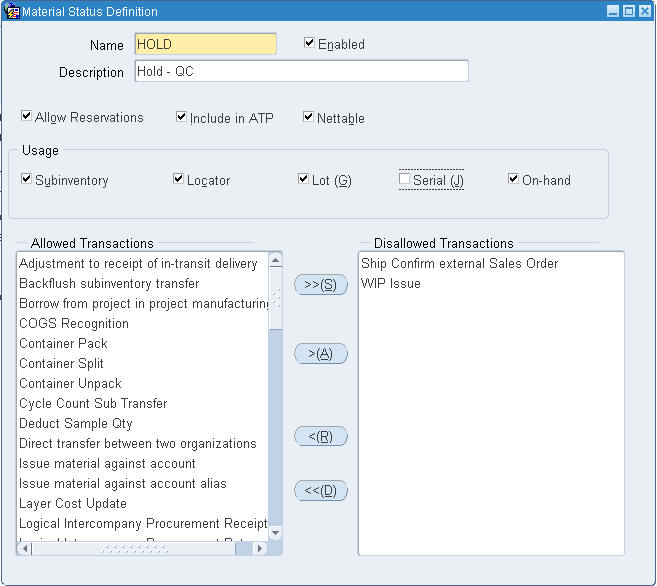Material Status Control
This chapter covers the following topics:
Overview of Material Status
Material Status control restricts the movement and usage of portions of on-hand inventory. Using material status control enables you to control whether you can pick or ship an internal order or sales order, or issue material for a work order. You can also specify whether material needs to be quarantined until you inspect it. In addition, you can determine whether products with a particular status can be reserved, included in available to promise calculations, or netted in production planning. You assign material statuses at four levels: subinventory, locator, lot, and serial.
You assign subinventory and locator statuses in the subinventory and locator windows. The location status applies to the material in the location and not the location itself. To assign a material status to a lot or serial, you must first enable the item attributes Lot Status Enabled, and Serial Status enabled on the item in the Item Master. You can also optionally assign a default lot or serial status to an item on the Item Master. When you receive the item, the system automatically assigns the default lot or serial status to the item. The lot or serial status remains the same through all inventory transactions including organization transfers. If necessary, you can change the material status at receipt, or use the material workbench or mobile status update page to modify the material status. For more information about setting up lot and serial statuses see Inventory Attribute Group.
You can track material status at the Subinventory, Locator, Lot, or On-hand balance levels. When you track material status at the on-hand level for an organization, the material status assigned at the Subinventory, Locator, or Lot level will be used to default on-hand level material status and the on-hand material will have a status associated with it. To enable the On-hand Material Status tracking option, run the Activate On-hand Level Material Status Tracking concurrent request.
Material Status Transactions
A material status is a combination of transactions and planning actions that you choose to disallow in a particular circumstance. Disallowed transactions and planning actions are cumulative. When you set up transaction types, you determine whether some transactions can be restricted by material status. The transactions for which you enable status control in the Transactions Types window appear in the Material Status Definition window. If you do not enable status control for a transaction type, then the transaction type is always allowed.
You can also assign the planning attributes Allow Reservations, Include in ATP, and Nettable to the material statuses that you create. When you transact an item, the system checks all of the material statuses. If the system finds a status that disallows the transaction, whether at the serial, lot, locator, or subinventory level, then the transaction fails.
The following table provides examples of material statuses that you might set up for your organization. In this example, each status either allows or disallows certain transactions. For example, the material status of Active allows all transactions and disallows no transactions. Conversely, the material status of Immature allows picking and shipping for internal customer orders, but disallows these transactions for external customer orders.
| Status | Active | Hold | Immature | Almost Mature |
|---|---|---|---|---|
| Disallowed | Nothing | Picking, shipping, and production | Picking and shipping for external customers | Shipping for customer |
| Allowed | Everything | Subinventory transfers | Picking and shipping for internal customers | Picking for customer |
Setting Up Material Status Control
Before you set up material status codes, you need to identify the transaction types to restrict.
-
Navigate to the Material Status Definition window.

-
Enter a name and a description for the material status.
-
Verify that the Enabled check box is selected. Deselect the Enabled check box if you do not want to use the material status.
Note: You cannot disable a material status that the system currently uses. Verify the material status is correct before using it in transactions.
-
Select Allow Reservations. If you select this check box, then you can view material associated with this status in the Item Reservations window. You can create a reservation against the material, and the system includes it in the available to reserve calculations. See Item Reservations for more information.
-
Select Include in ATP if you want material associated with this status to be eligible for available to promise. The system then includes material with this material status in available to promise calculations.
-
Select Nettable to include material that is associated with this material status with main planning.
Note: You cannot apply a status that is non-reservable, non-nettable, or non-ATPable to serials.
-
Indicate whether this status is used at the subinventory, locator, lot, serial, or on-hand level. Consider the following uses:
-
Subinventory: For example, if you select subinventory, the system enables you to assign the material status at the subinventory level.
-
On-hand: Enables checking of material status at the on-hand level.
-
-
In the Allowed Transaction column, select a transaction that you want to disallow and click the greater than button. To move a transaction from the Disallowed Transactions column to the Allowed Transactions column, select the transaction, and click the less than button.
-
Repeat the previous step to disallow additional transaction types.
-
Save your work.
Related Topics